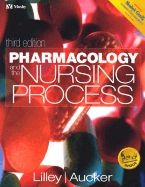Pharmacology And The Nursing Process

Subject
- Drug Therapy
- Nursing--Study Guides
- Pharmaceutical Preparations--Administration & Dosage
- Pharmacology
Plot
Pharmacology and the Nursing Process 3/e is a concise, readable text that presents pharmacology in an understandable manner. This new edition offers updated and revised content, keeping users up-to-date on the very latest pharmacology information. The third edition continues to retain the features that made it popular, including a body systems organization, key drugs highlighted for quick reference, case studies, nursing care plans, a drug profiles section with information on commonly used agents, a disorders index, study skills tips, and more! An abundance of full-colour illustrations enhances the text and a full-color photo atlas of medication administration presents more than 120 step-by-step illustrations to clearly depict key steps. The third edition also offers new chapters on herbal remedies and substance abuse.·· Over 250 full-color illustrations explain how drugs work in the body and depict key pharmacologic principles· Innovative cartoon-illustrated Study Skills part openers cover study tips, time management, and test taking strategies related specifically to studying pharmacology· Nursing Process discussions in separate sections at the end of chapters present Assessment, Nursing Diagnoses, Planning, Outcome Criteria, Implementation, and Evaluation in a consistent, nursing process framework with an emphasis on monitoring side effects and patient education· Take Home Points boxes at the end of chapters summarize content in a bulleted format to help students review major concepts· Full-color Photo Atlas of Medication Administration includes over 120 step-by-step illustrations on drug administration by various routes· Consistent chapter format facilitates student learning and understanding of key concepts· Representative or prototype Key Drugs are highlighted with an icon for quick identification· Chapter opener pedagogy includes Objectives, Drug Profiles box, and a Glossary with definitions and page references to help students mentally organize content· Glossary terms are bolded and in color in the narrative to emphasize essential terminology· Individual drugs are encapsulated in shaded Drug Profiles sections to highlight individual drugs, pharmacokinetics, and their unique variations· Cultural Implications boxes present differences to expect among cultural or ethnic groups to prepare nurses to work with an increasingly diverse patient population· Pediatric and Geriatric Considerations boxes highlight important lifespan implications of drug therapy· Patient Teaching Tips at the end of each chapter highlight useful patient education information specific to each drug group· Case Studies with critical thinking questions reflect the real world of clinical practice with specific patients from various cultures and age groups· Nursing Care Plans promote understanding of the nurse's role in drug therapy with nursing diagnoses, subjective and objective data, and outcome criteria· Separate disorders index alphabetically references disorders in the text to aid in integrating the text with medical-surgical or adult health nursing course content· Body systems organization facilitates learning and provides an effective means to use the text in integrated programs· Drug Dosage Tables provide instant access to dosages and routes for individual drugs, alphabetized for easy referral· Legal and Ethical Principles boxes promote awareness of liability issues and proper professional conduct· Research boxes synopsize recent nursing research to promote quality, evidence-based practice· New Interactive Worksheets icons in the text link corresponding content to the MERLIN website· New Herbal Interactions boxes provide documented interactions for commonly used herbal products· New chapter Over-the-Counter Drugs and Herbal Remedies presents uses, interactions, and patient education for over-the-counter and herbal products· New multiple-choice Review Questions help students review for the pharmacology component of the NCLE


 English
English  Nederlands
Nederlands  Deutsch
Deutsch  Français
Français  Español
Español  Magyar
Magyar  српски
српски  Dansk
Dansk  Italiano
Italiano  Svenska
Svenska  Slovenčina
Slovenčina  Português
Português 
